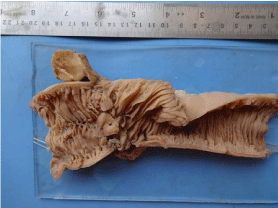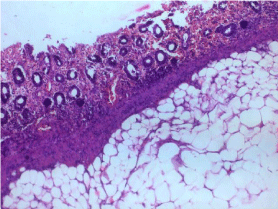
Case Report
Austin J Cancer Clin Res 2015;2(4): 1041.
Ileoileal Intussusception in an Adult Due to Ileal Lipoma – A Rare Case Report
Gupta P¹, Brown A¹, Musa O² and Srivastava AN¹*
¹Department of Pathology, Era’s Lucknow Medical College & Hospital, Lucknow, India
²Department of Surgery, Era’s Lucknow Medical College & Hospital, Lucknow, India
*Corresponding author: Srivastava AN, Department of Pathology, Era’s Lucknow Medical College & Hospital, Lucknow, India.
Received: April 24, 2015; Accepted: June 05, 2015; Published: July 29, 2015
Abstract
Small Intestine tumors are rare, accounting for 1-2% of all gastrointestinal tract tumors. Among these, benign tumors are extremely rare with small intestinal lipomas being even more uncommon. They are usually asymptomatic, but may rarely cause intussusception and intestinal obstruction. We report a case of adult male presenting as sub-acute intestinal obstruction. Exploratory laprotomy revealed ileo-ileal intussusception secondary to lipoma which was successfully treated with segmental intestinal resection.
Intestinal intussusception in adults is rare and majority of the cases has an underlying cause with intraluminal lesions that requires surgical resection. A differential diagnosis of lipoma should always be kept in mind as a cause of intestinal intussusception, without a delay in proper treatment.
Keywords: Adult Intussusception; Small intestine; Lipoma; Intestinal obstruction; Ileoileal
Introduction
Intussusception occurs when a proximal portion of the bowel called intussusceptum invaginates into the distal portion of the bowel called intussuscipiens [1-5]. Intussusception is a common condition in children, but rare in adults. Cause for paediatric intussusceptions is idiopathic in 90% of cases. Pneumatic or hydrostatic reduction of the intussusception is sufficient to treat the condition in 80% of the patients. Adult intussusception represents 5%-16% of all cases of intussusceptions and 1%-5% of all cases of intestinal obstruction [1-3,5-11]. Intussusceptions in adult have an organic lesion such as carcinoma, polyps, meckel’s diverticulum, colonic diverticulum, strictures or benign neoplasms in 70-90% of cases. Malignancy (adenocarcinoma) accounts for up to 30% of cases of intussusception occurring in the small intestine [12,13]. Due to significant risk of associated malignancy, radiological decompression is not recommended and definitive treatment, most often a surgical resection is needed, so a definitive diagnosis has to be made. Gastrointestinal lipomas are rare benign tumors and intussusceptions due to a gastrointestinal lipoma constitute an infrequent clinical entity. The majority of lipomas in the small bowel are solitary and approximately 5% are multiple [14]. Symptomatic lipoma manifestations are haemorrhage or intestinal obstruction. Here we report a case of small bowel lipoma in an adult male presenting with intestinal obstruction due to ileo-ileal intussusception.
Case Presentation
A 60-year-old male, presented with chief complaint of pain in abdomen since one week. The patient had no past history of peptic ulcer disease, alteration in bowel habits, melena or weight loss. On examination bowel loops were felt on abdominal palpation. Routine investigations were within normal limits. Ultrasonography showed dilated loops in lower abdomen showing feeble to absent peristalsis with minimum intra-bowel fluid suggestive of sub-acute intestinal obstruction.
On exploratory laparotomy ileo-ileal intussusception was present, 2 feet proximal to ileocaecal junction with polyp like growth in mucosal surface as a lead point of intussusception. Resection and ileo-ileal anastomosis was done. Grossly, the cut surface shows globular, pedunculated yellow and waxy growth measuring 3.5 X 2.3 cm. located 1 cm. from one resection end (Figure 1). Microscopically, section from growth showed sheets and lobules of adipocytes having eccentric nucleus & clear cytoplasm. Overlying ileal mucosa showing partially flattened villi lined by tall columnar cells and scattered goblet cells. (Figure 2) and other focal areas of intestine showed gangrenous changes. A histopathological diagnosis was reported as intussusception as a complication of S intestinal lipoma.

Figure 1: Gross showing a pedunculated Lipoma attached to mucosal
surface of small intestine.

Figure 2: Section show sheets and lobules of adipocytes below the mucosa
(H&E, 40x).
Discussion
Schematically, intussusception could be described as an “internal prolapse” of the proximal bowel with its mesenteric fold within the lumen of the adjacent distal bowel as a result of overzealous or impaired peristalsis, further obstructing the free passage of intestinal contents and, more severely, compromising the mesenteric vascular flow of the intussuscepted segment. The result is bowel obstruction and inflammatory changes ranging from thickening to ischemia of the bowel wall. The most common locations in the gastrointestinal tract where an intussusception can take place are the junctions between freely moving segments and retroperitoneally or adhesionally fixed segments [15]. Up to 90% cases of intussusceptions in adults are secondary to underlying pathology and have a lead point. Most lead points in the gastrointestinal tract involve primary or metastatic malignancy, lipomas, leiomyomas, adenomas, neurofibromas, postoperative adhesions, Meckel’s diverticulum, foreign bodies, vascular anomalies, lymphoid hyperplasia, trauma, celiac disease, cytomegalovirus colitis, lymphoid hyperplasia secondary to lupus, Henoch-Schönlein purpura, Wiskott-Aldrich syndrome, appendiceal stump, or inflammatory fibroid polyps [1,4,16-18].
In adults, intussusceptions may only present with vague abdominal symptoms or rarely with the classic triad of vomiting, abdominal pain and passage of blood per rectum, so the diagnosis is difficult [19]. Lipomas are usually asymptomatic. Intestinal lipomas larger than 2 cm may cause complications such as intestinal obstruction or bleeding. Malignant degeneration of lipomas has never been noted [20]. According to the literature, only 32% to 50% of cases are diagnosed pre-operatively. Complete bowel obstruction is found in less than 20% cases. Computed tomography is the method of choice for diagnosing intussusceptions. For adult intussusceptions treatment with symptomatic intestinal lipoma of choice is surgical resection. The advantages of intra-operative reduction of the intussusception prior to resection, especially when the small bowel is affected, are that it may preserve a considerable length of bowel and thereby prevent development of short-bowel syndrome.
The treatment for small bowel lipomas depends on the clinical manifestations and size. It is not clear whether asymptomatic small lipomas require any intervention, but conservative treatment is often indicated [21]. Surgical resection is indicated if lipomas are symptomatic or to rule out the liposarcomas by performing their histological examination [22]. Elective explorative laparotomy and laparoscopic-assisted resection of lipomas is the best approach because it is less invasive than conventional open surgery. Immediate surgical intervention is mandatory in cases of obstruction, massive haemorrhage or intussusceptions [22].
Conclusion
The diagnosis of intussusception in adults can be difficult because of atypical and episodic symptoms. A cause of intussusception in adults as a complication of lipoma should always be kept in mind as the treatment usually requires formal resection of the involved bowel segment in symptomatic cases.
References
- Ahn JH, Choi SC, Lee KJ, Jung YS. A clinical overview of a retrospective study about adult intussusceptions: focusing on discrepancies among previous studies. Dig Dis Sci. 2009; 54: 2643-2649.
- Ghaderi H, Jafarian A, Aminian A, Mirjafari Daryasari SA. Clinical presentations, diagnosis and treatment of adult intussusception, a 20 years survey. Int J Surg. 2010; 8: 318-320.
- Wang N, Cui XY, Liu Y, Long J, Xu YH, Guo RX, et al. Adult intussusception: a retrospective review of 41 cases. World J Gastroenterol. 2009; 15: 3303-3308.
- Yakan S, Caliskan C, Makay O, Denecli AG, Korkut MA. Intussusception in adults: clinical characteristics, diagnosis and operative strategies. World J Gastroenterol. 2009; 15: 1985-1989.
- Marinis A, Yiallourou A, Samanides L, Dafnios N, Anastasopoulos G, Vassiliou I, et al. Intussusception of the bowel in adults: a review. World J Gastroenterol. 2009; 15: 407-411.
- Theodoropoulos GE, Linardoutsos D, Tsamis D, Stamopoulos P, Giannopoulos D, Zagouri F, et al. Gastrointestinal stromal tumor causing small bowel intussusception in a patient with Crohn's disease. World J Gastroenterol. 2009; 15: 5224-5227.
- Manouras A, Lagoudianakis EE, Dardamanis D, Tsekouras DK, Markogiannakis H, Genetzakis M, et al. Lipoma induced jejunojejunal intussusception. World J Gastroenterol. 2007; 13: 3641-3644.
- Mohamud SO, Motorwala SA, Daniel AR, Tworek JA, Shehab TM. Giant ileal inflammatory fibroid polyp causing small bowel obstruction: a case report and review of the literature. Cases J. 2008; 1: 341.
- O'Kane AM, O'Donnell ME, McCavert M, Taylor K, Lee J, Wilkinson AJ. Inflammatory fibroid polyp of the ileum causing recurrent intussusception and chronic ischaemia: a case report. Cases J. 2008; 1: 244.
- Coulier B, Maldague P, Broze B, Gielen I. Ileal inflammatory fibroid polyp causing ileocolic intussusception. JBR-BTR. 2008; 91: 149-152.
- Malik KA, Pande GK, Aftab Z, Nirmala V. Inflammatory fibroid polyp of the ileum causing intussusception. Saudi Med J. 2005; 26: 995-998.
- Begos DG, Sandor A, Modlin IM. The diagnosis and management of adult intussusception. Am J Surg. 1997; 173: 88-94.
- Tan KY, Tan SM, Tan AG, Chen CY, Chng HC, Hoe MN. Adult intussusception: experience in Singapore. ANZ J Surg. 2003; 73: 1044-1047.
- Atila K, Terzi C, Obuz F, Yilmaz T, Füzün M. Symptomatic intestinal lipomas requiring surgical interventions secondary to ileal intussusception and colonic obstruction: Report of two cases. Ulus Travma Acil Cerrahi Derg. 2007; 13: 227–231.
- Sachs M, Encke A. [Entero-enteral invagination of the small intestine in adults. A rare cause of "uncertain abdomen"]. Langenbecks Arch Chir. 1993; 378: 288-291.
- Hsieh TM, Sheen-Chen SM, Lin CC. Combination of adult intussusception and intestinal malrotation: an unusual presentation. Dig Dis Sci. 2008; 53: 3037-3039.
- Akbulut S, Sevinc MM, Cakabay B, Bakir S, Senol A. Giant inflammatory fibroid polyp of ileum causing intussusception: a case report. Cases J. 2009; 2: 8616.
- Gara N, Falzarano JS, Limm WM, Namiki TS, Tom LK. Ileal inflammatory fibroid polyp causing chronic ileocolic intussusception and mimicking cecal carcinoma. World J Gastrointest Oncol. 2009; 1: 89–92.
- Aminian A, Noaparast M, Mirsharifi R, Bodaghabadi M, Mardany O, Ali FA, et al. Ileal intussusception secondary to both lipoma and angiolipoma: a case report. Cases J. 2009; 2: 7099.
- Manouras A, Lagoudianakis EE, Dardamanis D, Tsekouras DK, Markogiannakis H, Genetzakis M, et al. Lipoma induced jejunojejunal intussusception. World J Gastroenterol. 2007; 13: 3641-3644.
- Alberti D, Grazioli L, Orizio P, Matricardi L, Dughi S, Gheza L, et al. Asymptomatic giant gastric lipoma: What to do? Am J Gastroenterol. 1999; 94: 3634-3637.
- Akyildyiz H, Biri I, Akcan A, Küçük C, Sözüer E. Ileal lipoma: case report. Erciyes Tip Dergisi. 2011; 33: 083–086.